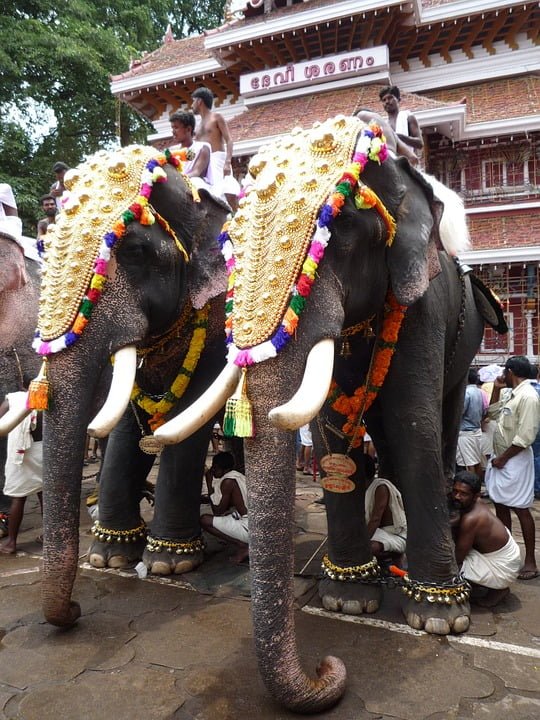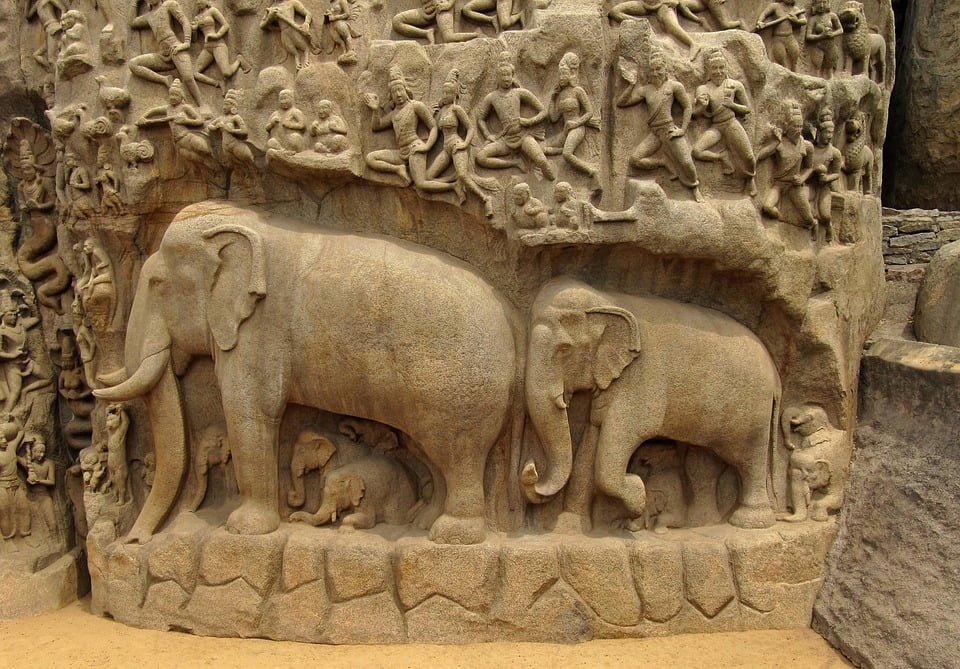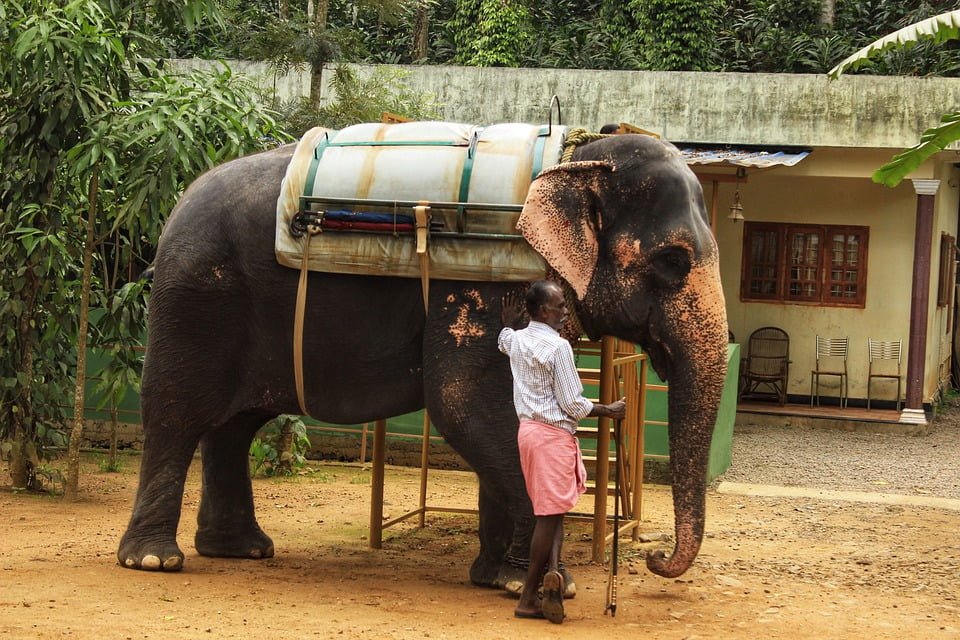In India, elephants are more than wildlife. They are pampered. Revered. Loved. And worshipped. India is a home for elephants. Currently, the country has 55% of the population of Asian elephants. Amongst which South Indian states Karnataka, Kerala, Andhra Pradesh, and Tamil Nadu have 44% of the elephants. Karnataka has the highest number of elephants in India. The number speaks of myriad observations why Indians worship elephants. Come join us as we demystify this and learn more fascinating facts about elephants.
Quick Navigation
Why are elephants sacred in India?
- Indians consider taking the blessings of an elephant as an obstacle remover. They are also considered as the form of Goddess Lakshmi Devi and Lord Ganesha who are considered to be prosperity bringers.
- Elephants have been worshipped and pampered during the kings’ times in Bharat. The number of elephants in the army of a king resembled its strength and warfare stamina.
- Historical tales indicate that even the army of mighty Alexander the Great could not win over the Indian war elephants.
- Not only in warfare, but the role of elephants in building ancient Indian architectural marvels like Brihadeeswara temple and Konark temple is notable. They played a crucial role in carrying heavyweights to the construction sites and helped engineers of ancient India.
- Even today, in places where modern engineering equipment cannot reach due to poor roads or terrain, elephants are widely used for transporting heavy loads and timber.
- Various cave paintings, coin inscriptions, and images from early civilizations like Harappa and Mohenjo-Daro contain elephants. They prove that elephants are worshipped and cared for in ancient India.
- Temples in South India also have their role to play in passing on their sanctity. Temple goers do take blessings from these temple elephants believing that they are divine.
Not only in India, but elephants are regarded as spiritual symbols across many global cultures too. The elephant is considered a sacred animal in Asian countries such as Thailand and Burma, and Africa. There are instances where Burman kings waged wars over the possession of white elephants.

What does an elephant symbolize?
Elephants symbolize royalty, majesty, strength, divinity, abundance, fertility, wisdom, observation, destructive power, and learning. Along with these, elephants symbolize various qualities that we should learn:
- An elephant is the strongest mammal. It is slow, patient, and vegetarian.
- Elephants are the advanced stages of evolution when it comes to brain structure. Amongst all animals, the brain of elephants is the most advanced in complexity on par with humans.
- The eyes of an elephant are small, and its ears are big. It indicates that one should be attentive and listen more.
- The trunk of an elephant is long, and the sound reflects the OM sound, the celestial sound revered in Hinduism.
- An elephant lives in groups, teaching us the importance of social life. They are very patient, mellow, and friendly unless you threaten their young ones or the herd.
- Elephants are vegetarian and prove that one can grow strong and wise with vegetarian food and without killing other creatures.
- Elephants are known for their loyalty. In Kerala and Karnataka, you can hear stories about elephants that refuse to eat or do anything when their mahouts die.
- Though elephants are big in size, they never threaten other animals or humans unless they sense danger. Thus, they teach us that it is a coexistence that is important but not dominant.
Due to such elephant symbolism, they find a place in Vastu, Fengshui, mandala, Indian handicrafts, and other spiritual practices that help to infuse health and happiness to humans. An elephant with its trunk up symbolizes blessings and fulfillment of wishes. Keeping elephant pics, idols, and paintings is considered lucky according to such beliefs.
Vasudhaiva Kutumbakam: The Timeless Philosophy of India’s Global Harmony
Significance of Elephant in Hinduism
The Sanatana Dharma of Hinduism holds the utmost prominence to elephants. Though we do not find direct mention of elephants in the Vedas, there are various instances where we find the tales of their greatness.
- According to Hindu beliefs, the Earth is protected by 8 divine elephants on eight sides on their backs.
- The Gajendra Moksham of Bhagavata Purana is widely known. According to this epic, Lord Vishnu himself comes from Vaikuntha to Earth to save his ardent devotee, Gajendra – an elephant, from the clutches of a crocodile.
- Lord Indra has Airavata, a white elephant with wings, as his vehicle. Airavata originated during the Sagara Mathan, the churning of the cosmic milk ocean by Gods and Demons. Airavata is a milky white elephant and is considered the sibling of Goddess Lakshmi. The elephant is five-faced with ten tusks.
- The elephant is also a vehicle for Goddess Lakshmi and Vishwakarma – the divine engineer who designed the Universe. One of the eight forms of Goddess Lakshmi is Gaja Lakshmi – which means Lakshmi who comes on an elephant to bless her devotees with abundance.
- The story of lifeless little Ganesha coming back to life with the help of an elephant head needs no introduction. Ganesha, the divine son of Goddess Parvati, finds his second life with the help of the head of Gajasura – the elephant demon blessed by Lord Shiva. Ganesha is the supreme God for Hindus in seeking removal from obstacles and Ganesh Chaturthi marks the significance of this event. Thus, the elephant head primarily represents Ganesha as an obstacle remover.
- According to Hindus, one cannot easily get an elephant ride. A ride on an elephant is destined only for those with luck, raja yoga, and good karma. It was a tradition to respect scholars with a ride on the elephant to honor their knowledge and wisdom.
- Even today, the practice of offering a gandapenderam ( a form of jewelry adorned to the legs of scholars similar to the one that an elephant wears to its foot) is the utmost respect one gives to the learned.
All these reasons explain why Hindus worship elephants. Karnataka Culture and Dances You Should Know

Significance of Elephants in Indian Religions
A white elephant is considered an auspicious sign if it appears in one’s dream. The mythical white elephant is revered not only by Hindus but also by people of all religions of India owing to its religious significance.
Islam: According to Islam, Prophet Muhammad was born in the year 570, recognized as the Year of Elephant. A chapter called White Elephant in the Quran mentions how a white elephant of Abraha, ruler of Yemen, led 40,000 soldiers but refused to enter Mecca when he planned to demolish the Kaaba.
Buddhism: According to Buddhism, the mother of Buddha – Queen Maya Devi did not become pregnant till she saw a white elephant in her dream. In the dream, a white elephant circled her three times, offered her a lotus flower, and then sought her blessings before it entered her womb. The royal priests then decoded this dream as the most auspicious one that leads to the birth of a world conqueror and an Enlightened one who is none other than Gautama Buddha.
Christianity: According to Christians, the elephant is a symbol of docility, sobriety, and piety. Christian kings wear a collar with an elephant symbol as a symbol of the same.
India’s New Parliament Building

Significance of temple elephants of India
Temple elephants of India have always been an interest of curiosity for foreigners. The way they are adorned with jewelry and clothes, the respect and joy people shower at their sight piques the curiosity to the onlookers.
In temples of Kerala, Andhra Pradesh, and Karnataka, you can find many temple elephants. Generally, a mahout always stays with them and cares for them. These temple elephants bless people who approach them. In return, they pay a small amount or offer fruits as a token of gratitude and maintenance.
The Guruvayoor Temple in Kerala alone has more than 50 elephants. The temple elephants are an integral part of the Keralites’ lifestyle. No festivity happens either in personal life or in the temples without the involvement of an elephant procession. Facts about India for kids
Not only for Hindu festivals, but they are integral for Muslim and Christian celebrations too. Pattambi mosque in Palakkad and Jacobite Church in Thrissur are examples that use them for their festive celebrations.
Gajarajan Guruvayur Keshavan (1912—1976) is perhaps the most famous and celebrated temple elephant in Kerala, India. Initially captured in the Nilambur forest, this elephant served the royal families before they donated it to the Guruvayur temple. It is the only elephant to have served the temple longest to date in helping the procession of the Utsava Murthi (an idol that is meant for processions). One should not miss the event of elephant decoration and race during the Onam festival.
Even during the world-renowned Tirumala Brahmotsavam, it is a custom to take the Lord Malayappa idol on an elephant around the Mada streets.

Significance of elephant in Indian art
The elephant symbol is one of the most widely used symbols in Indian art and handicrafts. Many Indian ethnic works include elephant symbols in their making – for instance, in saree designs, home décor, block prints, idols, statues for decoration of public places, etc.
Elephant carvings are also one of the prominent attractions in ancient Indian monuments. The Elephanta caves near Mumbai attain their name from the huge rock cut of elephants at its entrance.
Similarly, the Ganga Avtaran carving (the descent of the Ganges onto the Earth) near Mahabalipuram is also world-renowned for its intrinsic work depicting majestic animals.

Facts about Elephants
As interesting as they can be, facts about elephants say that elephants are fun-loving and joyous animals.
The gestation period of an elephant is 22 months, which is approximately two years! Interestingly, elephant calves stand up as soon as 20 minutes after their birth.
- The birth weight of a baby elephant is 95 kgs. An adult Asian elephant weighs 4000kgs.
- The smelling power of an elephant is very sharp. Its trunk can sniff water from as far as 12 miles.
- Elephants sleep only 2-3 hours per day. Adult elephants need 300kg of food and 160 liters of water per day.
- Elephants sprinkle dust on their back after a long clean bath. Do you know why? This dust acts as a sunscreen for them as their skin is sensitive to sunlight.
- The lifespan of an elephant is around 70 years.
- The trunk of an elephant alone weighs 140kg and can hold 12 liters of water.
- The tusks of elephants are actually their teeth. They help in food gathering and self-defense. Unfortunately, they are also the main reason why elephants are hunted.
- Ever wondered why an elephant’s skin is wrinkled? It is because it stores water amidst the wrinkles to provide moisture to its body.
- The memory power of elephants is amazing. They can even distinguish languages.
- By looking at the size, you may assume elephants can’t swim. But do you know? Elephants are excellent swimmers!
- World Elephant Day is celebrated on 12th August every year. The day honors their contribution to the ecosystem and reminds us about their conservation.
Swetha is a Content Specialist, LinkedIn Branding and B2B Marketing Consultant. When she is not in the world of B2B, she researches the roots and beauty of Indian Culture and Traditions. She is the author of the book: 365 Days 365 Posts – The Guide to LinkedIn Personal Branding, available exclusively on Amazon. Connect with her on LinkedIn.

